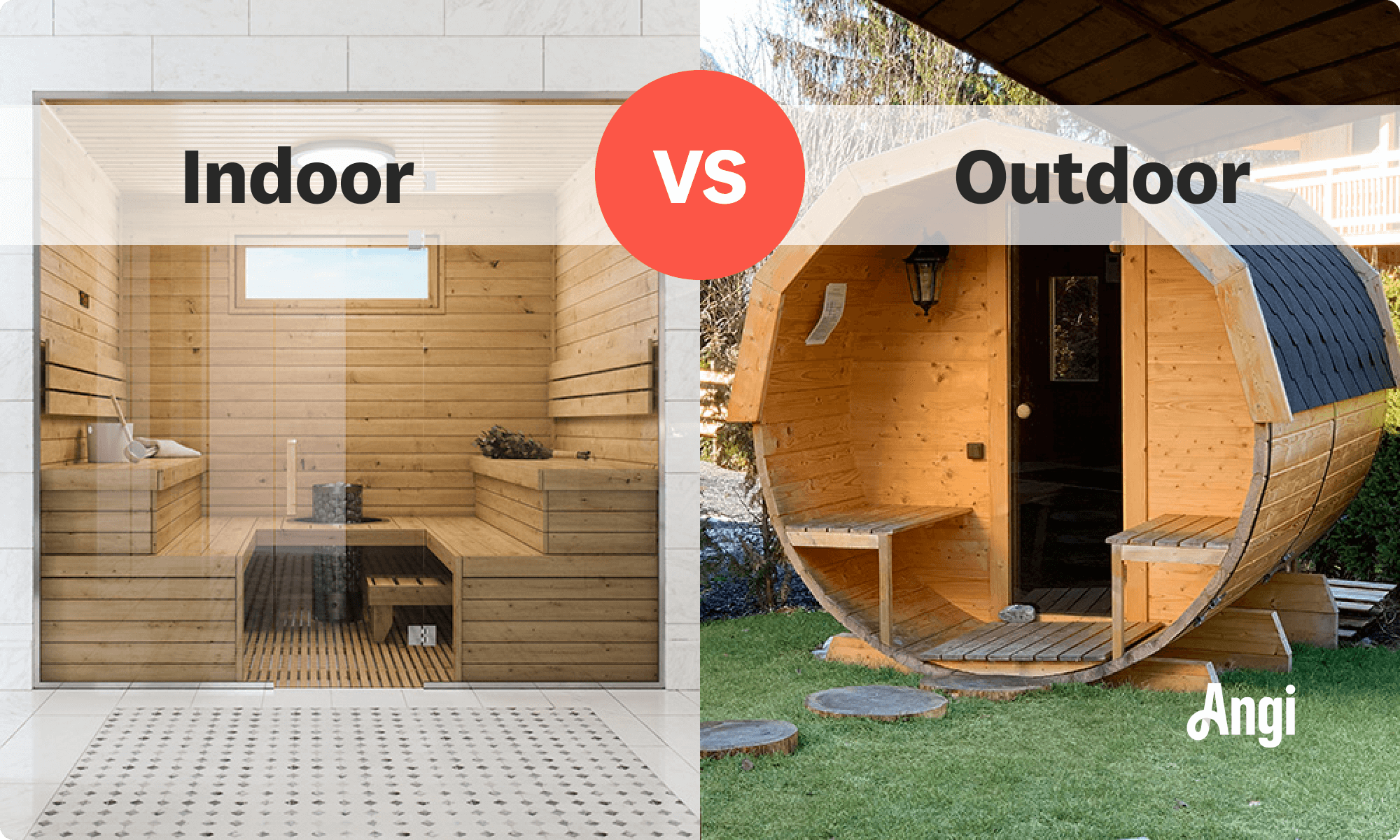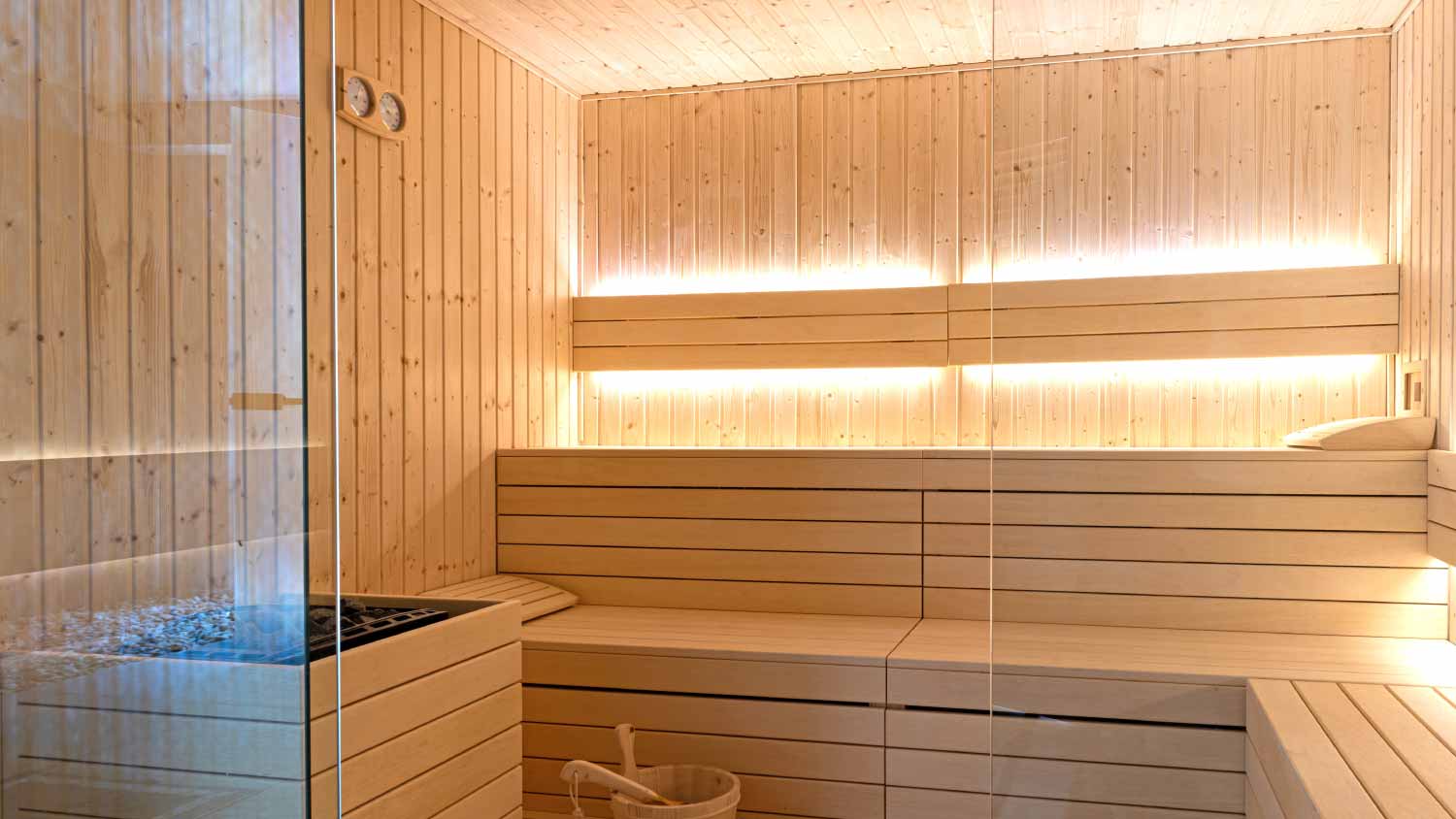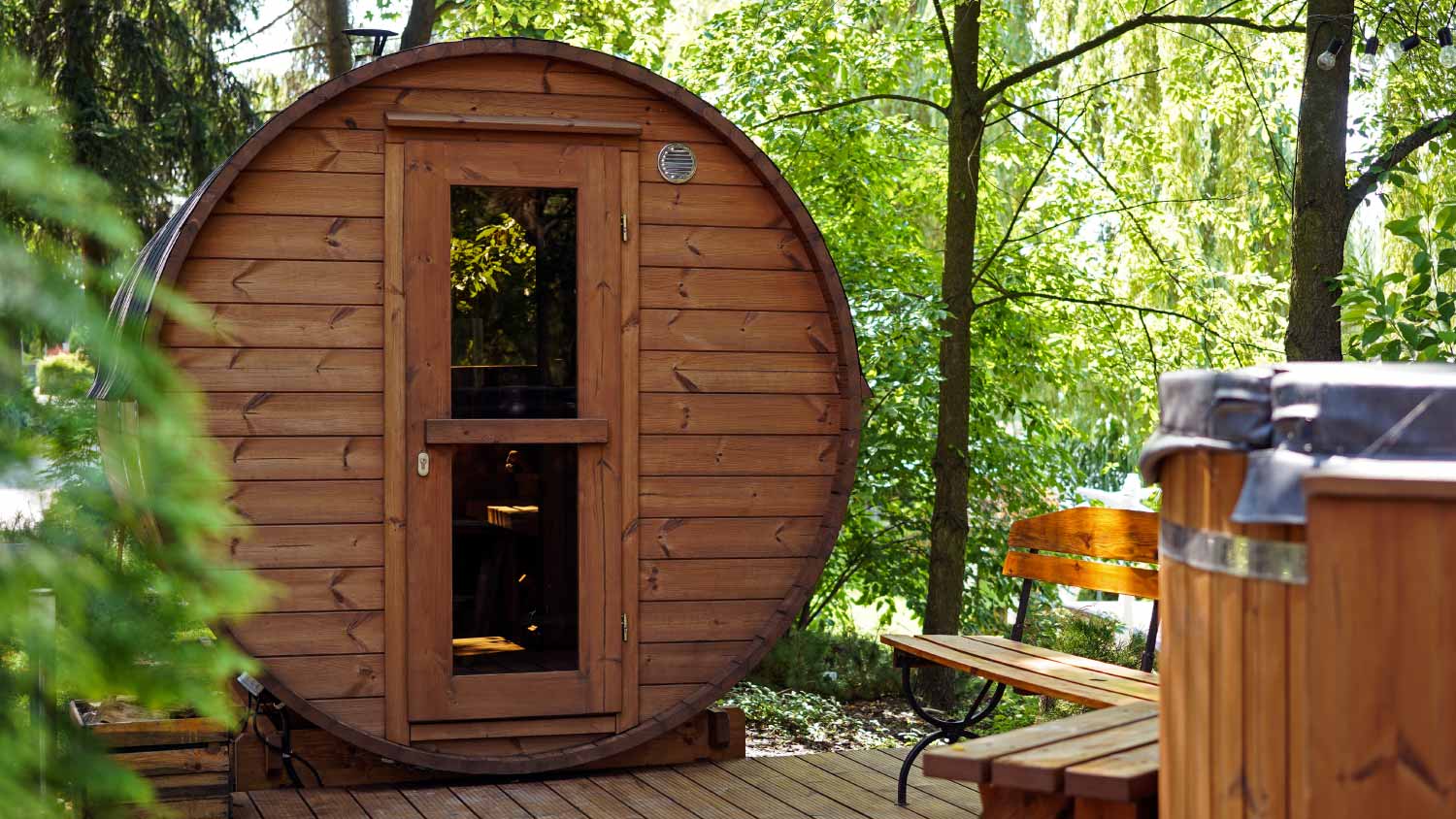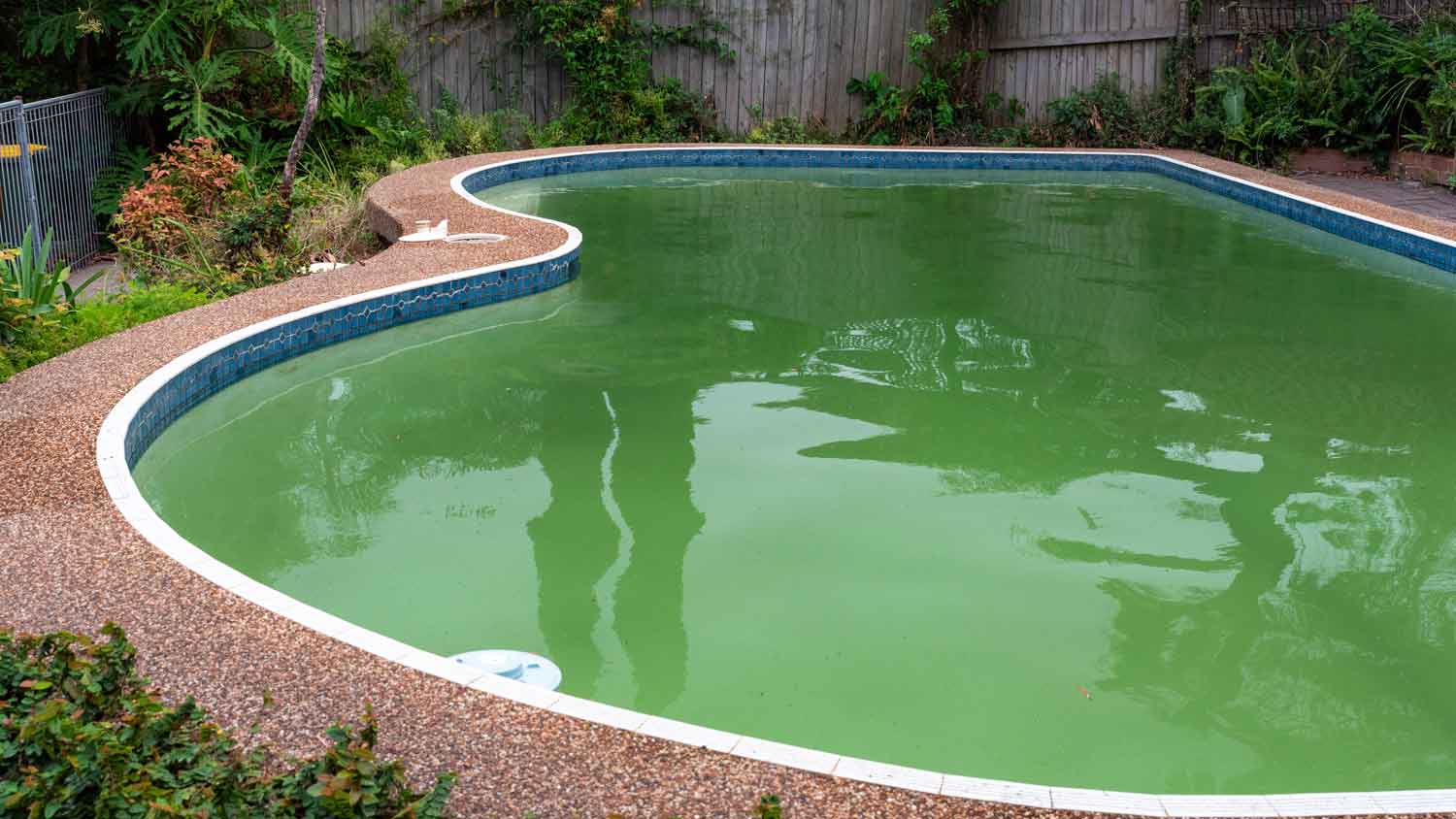Indoor vs. Outdoor Sauna: Which Should You Choose?
Consider your long-term needs when choosing between an indoor or outdoor sauna


If you have extra space and want total privacy, indoor saunas are a good choice.
Getting the exact design and layout is easier with outdoor saunas.
Indoor saunas are easier to maintain, while outdoor saunas are easier to install.
A sauna is great for relaxation and offers health benefits, so it seems like a no-brainer to put one in your home. At this point, you are probably wondering how to compare indoor vs. outdoor saunas. Here are some important things to consider before making your final decision.
Indoor vs. Outdoor Saunas: Key Differences

Indoor saunas are built into existing spaces in your home and may require more complex installation. Outdoor saunas are available in many different design options and can be installed anywhere in your yard.
What Are Indoor Saunas?

Indoor saunas are often put in principal bathrooms, basements, or next to home gyms. You can get a traditional sauna or a portable one. Either way, indoor saunas offer you plenty of privacy with easy maintenance.
| Pros | Cons |
|---|---|
| More privacy | Takes up valuable real estate |
| Longer life span | More complex installation process |
| Easier to maintain | Heats the home |
Best for:
People seeking easy sauna access
Homes with extra or unused space
Those looking for high levels of privacy
Pros of Indoor Saunas
Since it is in your home, you have the utmost privacy.
Indoor saunas are not exposed to the elements and therefore last longer.
It is easier to do pre- and post-session maintenance tasks since it is in your home.
Cons of Indoor Saunas
An indoor sauna takes up valuable real estate in your home.
Installation is more complex due to ventilation and drainage requirements.
The sauna will heat your home, which is a major drawback in hot areas.
What Are Outdoor Saunas?

Outdoor saunas are small freestanding buildings placed in your yard. You might put one next to a pool, if you have one. They are easier to install than indoor saunas, although it takes more work to maintain them.
| Pros | Cons |
|---|---|
| More design and customization options | Requires walking outside to access it |
| More visually appealing | Less privacy |
| Easier to install | More maintenance |
Best for:
Those who do not have space for an indoor sauna
Yards with privacy and great views
Areas with hot climates
Pros of Outdoor Saunas
Choose whatever design and size you want, as long as it fits in your yard
Tend to have better visual appeal than indoor units
The installation process is easier, although it requires running plumbing and electrical utilities to the unit.
Cons of Outdoor Saunas
It can be inconvenient to go outside in different weather to reach the sauna.
If you have nosy neighbors, the lack of privacy is a downside.
Exposure to the elements means more maintenance requirements.
Indoor vs. Outdoor Saunas
Check out all of the ways that indoor and outdoor saunas differ from one another—and which wins in each category.
Appearance: Outdoor Saunas
When it comes to looks, the outdoor sauna wins. There are many different design options available, including barrel-shaped, cabin-shaped, and raindrop-shaped ones. Depending on your yard and landscaping, an outdoor sauna can fit right in and even provide some amazing views from inside.
Indoor saunas can look great too, especially if you opt for modern glass doors or add stylish lighting throughout. The one type of indoor sauna that does not have much visual appeal is the portable variety, but it offers other advantages that make it worth considering.
Options and Customizations: Outdoor Saunas
If you want the greatest number of options and customizations, you should go with an outdoor sauna. Since you can build it from scratch in your yard, it can be customized to fit seamlessly into your home’s design. You will also have the freedom to choose the exact square footage and layout you want, since you do not have to squeeze the design into an existing room. Many people add large windows if there are great views.
On the other hand, installers build indoor saunas according to the specifications of an existing space. This might be an extra room, a space in the basement, or an ensuite bathroom. You will still have plenty of customization options, like deciding on the layout, material type, and more. You just have to work with the space you have.
Durability: Outdoor Saunas
Manufacturers build outdoor saunas to withstand harsh weather, so they are more durable than indoor ones. But whether you go with an indoor or outdoor unit, you should still look for high-quality wood. The most durable options include cedar and hemlock.
Price: Tie
Indoor home saunas cost $3,000 to $9,500, while outdoor saunas cost $3,000 to $12,000. If you are working with a set budget, you can likely choose either option as long as you are flexible on the manufacturer and design. Factors that drive up the cost of an indoor sauna include ventilation and water drainage systems.
Ease of Installation/DIYability: Outdoor Saunas
Installing an indoor sauna is complex whenever installing ventilation or water drainage is difficult. While you may consider venting into your house, it is not ideal, since all that extra moisture and heat can lead to mold growth.
On the other hand, it is easy to install ventilation and water drainage for outdoor saunas since they are freestanding buildings; however, you will need to install a foundation and add electricity and water lines, which is a lot of work.
For both sauna types, you have to get the right permits and meet all building and electrical code requirements. Depending on your location, you may have more requirements to meet for an indoor sauna than an outdoor one.
Either way, doing the job yourself and learning how to build a sauna is only possible for the most experienced DIYer. Only attempt it if you have the right skills and experience to do it properly. Otherwise, you should hire a sauna installer near you.
Ease of Repair/DIYability: Tie
If something goes wrong with the sauna, you are likely going to need a pro’s help regardless of whether it is an indoor or outdoor unit. Common problems like electrical, plumbing, or thermostat malfunctions are not easy to fix yourself. Moreover, if the problem is with the heater, you should bring in a spa expert to help with troubleshooting. More basic repairs, like replacing a cracked window or fixing broken wood panels, are DIY-friendly.
Maintenance: Indoor Saunas
Both indoor and outdoor saunas require proper maintenance before and after you use them; however, indoor saunas are easier to maintain since they are inside your home.
Outdoor saunas require more work because you have to maintain the exterior. This includes power washing the wood paneling periodically, as well as staining the wood with a UV inhibitor. Plus, it takes extra effort to do all of the regular maintenance tasks, like airing out the sauna after each use, since you have to walk back and forth from your house to the sauna.
Length of Life: Indoor Saunas
An indoor sauna can last 20 to 25 years or more, whereas an outdoor one lasts 15 to 25 years. The actual life span will vary depending on the quality of materials and how well you maintain them. Since outdoor saunas are exposed to all of the harsh weather conditions in the summer and winter, they usually do not last as long as indoor ones.
Eco-Friendliness: Tie
The eco-friendliness of a sauna depends more on its heat source than whether it is an indoor or outdoor unit. Rather than using a wood-burning stove, you might opt for an energy-efficient electric heater or an infrared heater. Also, you can look for manufacturers that build with reforested or sustainably harvested wood.
ROI: Tie
The ROI of both indoor and outdoor saunas is around 42%. This is because not everyone wants or likes saunas, so you should get a sauna for your benefit only and not as an investment for a future home sale.





- Buying a Sauna for the Home: 10 Sweat-Free Tips You Need to Know
- Infrared Sauna vs. Traditional Sauna: Which Is Best for You?
- Who Do You Call to Install a Sauna for Your Home?
- Steam Shower vs. Sauna: Which Is the Best for Your Home Spa?
- Where to Put a Sauna in Your House
- Considering an Outdoor Kitchen? Read This First
- 21 Outdoor Living Trends to Get Creative With in 2024
- How to Build a DIY Outdoor Kitchen From Concept to Construction
- 11 Outdoor Kitchen Designs Any Home Chef Will Love
- Indoor Air Quality Checklist: How to Test and Improve the Air in Your Home










